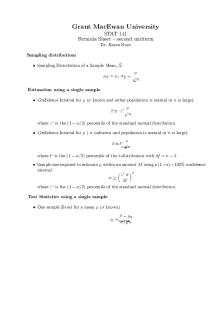Microscopy - Lecture notes 2 PDF

| Title | Microscopy - Lecture notes 2 |
|---|---|
| Course | Cell Biology |
| Institution | Middle Georgia State University |
| Pages | 3 |
| File Size | 90.3 KB |
| File Type | |
| Total Downloads | 51 |
| Total Views | 130 |
Summary
Full lecture notes on microscopy for cell biology with christine rigsby....
Description
Microscopy Monday, August 24, 2020
10:56 PM
*Know different types and how theyre used Identify them Compare and contrast different types based on a description Know limitations Know what you can and cannot see REFER TO PANEL 1-1 *Stained cells, only one type of organelle seen=light microscopy* Some types of microscopy Optical (light) - Fluorescence - Confocal (fluorescence) - Super-Resolution Electron - Scanning (SEM) - Transmission (TEM) - Scanning-tunneling, etc. Atomic Force (INDIRERCT IMAGE)
Optical (Light) Microscopy) Magnify up to 1000x - Total magnification calculated by ocular power * objective Resolution 0.2 um (200nm - 300nm) Need light source, prepared specimen, set of lenses • Different staining changes how light passes through the specimen changing how you're able to view it. • Uses the refraction of light rays to magnify an object - A condenser directs light towards the specimen - The objective lens collects light from the specimen - The ocular lens forms an enlarged virtual image *Be able to identify different parts of a microscope especially for lab Magnification is making something bigger. Resolution is being able to see distinct objects. 4 objects that appear bigger is increasing magnification. 4 objects that actually are 8 in an increase in resolution. • The numerical aperture is a measure of the light-gathering qualities of a lens • The limit of resolution depends on the wavelength of light (Changing wavelengths- using different colored lights- can change the resolution) • Optical flaws, or aberrations, affect resolving power
Visibility: deals with factors that allow an object to be observed - It requires that the specimen and the background have different refractive indexes - Translucent specimens are stained with dyes - Bright-field microscopes: a light that illuminated the specimen is seen as a bright background; it is suited for specimens of high contrast such as stained sections of tissues. (Can see all parts of cell even if not tagged) - A whole mount is n intact object, either living or dead - A section is a very thin slice of an object (Cells are immersed in a chemical called fixative, the rest of the procedures try to minimize alteration from the living state) • Phase-contrast Microscopy (to avoid staining because that makes the cell non-viable-looks at live cells) - Resolution 1-3 nm (0.001-0.003 um) - Makes highly transparent objects more visible by converting differences in the refractive index of some parts of the specimen into differences in light intensity - Differential interference contrast (DIC) optics gives a three-dimensional quality to the image
*Fluorescence Microscopy allowed for advances in live-cell imaging - Fluorochrome stains cause cell components to glow (fluorescence) - When attached to an antibody, its used to locate a specific cellular structure (immunofluorescence) - Allows you to see how things interact - FRET - Fluorescence resonance energy transfer- uses fluorochromes to measure changes in distance between labeled cellular components; energy is transferred from one GFP variant to the other variant (used to followed the change in conformation of a protein following cGMP binding) *Video Microscopy - Video microscopy is used to observe living cells - Charged-coupled device (CCD) cameras are very sensitive to light which allows them to image - specimens at very low illumination. They can detect and amplify very small differences in contrast *Confocal Microscopy - A laser scanning confocal microscope produces an image of a thing plan located within a much thicker specimen - A laser beam is used to examine planes at different depths in a specimen - Can change mirrors to change focus…will give you a series of images
Laser scanning confocal microscopy - Confocal fluorescence micrographs of three separate optical sections - Can make an image through a structure to see how something passes through structure *STORM - Breaking the light microscope's limit of resolution - Allows the localization of a single fluorescent molecule within a resolution of...
Similar Free PDFs

Microscopy - Lecture notes 2
- 3 Pages

microscopy workshop 2 analysis
- 14 Pages

different microscopy
- 4 Pages

Lecture notes, lecture 2
- 3 Pages

2 - Lecture notes 2
- 5 Pages

Lecture notes, lecture Chapter 2
- 11 Pages

CM-handouts - Clinical Microscopy
- 32 Pages

Lecture notes, lecture formula 2
- 1 Pages
Popular Institutions
- Tinajero National High School - Annex
- Politeknik Caltex Riau
- Yokohama City University
- SGT University
- University of Al-Qadisiyah
- Divine Word College of Vigan
- Techniek College Rotterdam
- Universidade de Santiago
- Universiti Teknologi MARA Cawangan Johor Kampus Pasir Gudang
- Poltekkes Kemenkes Yogyakarta
- Baguio City National High School
- Colegio san marcos
- preparatoria uno
- Centro de Bachillerato Tecnológico Industrial y de Servicios No. 107
- Dalian Maritime University
- Quang Trung Secondary School
- Colegio Tecnológico en Informática
- Corporación Regional de Educación Superior
- Grupo CEDVA
- Dar Al Uloom University
- Centro de Estudios Preuniversitarios de la Universidad Nacional de Ingeniería
- 上智大学
- Aakash International School, Nuna Majara
- San Felipe Neri Catholic School
- Kang Chiao International School - New Taipei City
- Misamis Occidental National High School
- Institución Educativa Escuela Normal Juan Ladrilleros
- Kolehiyo ng Pantukan
- Batanes State College
- Instituto Continental
- Sekolah Menengah Kejuruan Kesehatan Kaltara (Tarakan)
- Colegio de La Inmaculada Concepcion - Cebu







